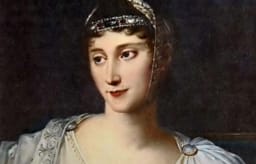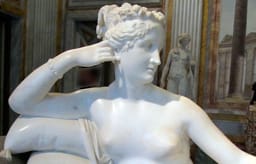Statue of Pauline Bonaparte as Venus Victrix
Galleria Borghese museums
Paolina Bonaparte, Napoleon's sister, was certainly wayward. Antonio Canova originally wanted to cast her as Diana, the chaste goddess of the hunt. This, however, was totally out of character.
 If there's one thing Paolina wasn't, it was chaste! She loved courting controversy and at that time, posing naked would have raised eyebrows. The statue was also a political statement.
If there's one thing Paolina wasn't, it was chaste! She loved courting controversy and at that time, posing naked would have raised eyebrows. The statue was also a political statement.
Commissioned in 1804 by Paolina's second husband, Prince Camillo Borghese, the change of subject to Venus Victrix was significant. The Borghese were nothing if not pretentious, seeing themselves as descended from Rome's founder Aeneas, the son of Venus.
As a Neoclassical sculptor, Canova was heavily influenced by the discoveries of Pompeii and Herculaneum. His work in marble always won praise for the way he breathed light and shadow into it, a skill seen to perfection in this piece which would originally have been viewed by candlelight. As well as being a sculptor Canova was responsible for acquiring the Vatican's works of art.
 The reclining Paolina unabashedly shows off her skin's soft texture and her graceful figure while elements in the statue pick up classical references such as the mass of curls that imitate ancient Greek hairstyles.
The reclining Paolina unabashedly shows off her skin's soft texture and her graceful figure while elements in the statue pick up classical references such as the mass of curls that imitate ancient Greek hairstyles.
In contrast, the position of her hands, one of which holds an apple, sums up Paolina's character with its suggestion of seductive promise.
The statue's original aristocratic audience would have been sophisticated enough to understand its classical allusions but the pose also gave weight to the rumours that surrounded this wayward lady, a lady always out of step with her contemporaries. She certainly didn't have a problem with posing nude, as long as the room was heated! Even now she is still attracting attention - a recent poll named her as Miss Italian Art.


